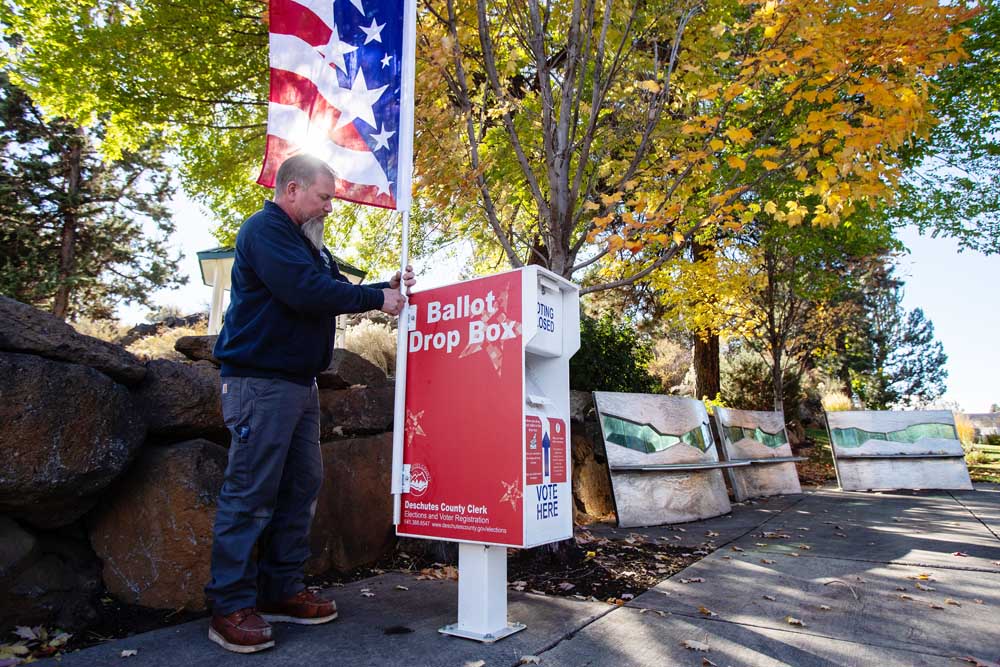Here’s what ballot security looks like from beginning to end in Deschutes County
Published 5:30 am Saturday, October 19, 2024

- Chris Stewart, a maintenance specialist for Deschutes County, attaches a flag to a ballot drop box outside the Deschutes Services Building on Oct. 17 in Bend.
In November 2000, Oregon made history by becoming the nation’s first state to vote exclusively by mail in a presidential election. The historic election saw a 78% voter turnout for Oregon, far outpacing the national average that year of 50%.
On Wednesday, ballots were mailed out for the 2024 election using a system Oregon has honed so well that Deschutes County Clerk Steve Dennison said it gives him confidence in democracy every single election.
“Vote by mail has been around for a long time. This process has been refined … There’s so many pieces and parts to the process that things can go wrong. We’re just humans trying to get this stuff right, but when everything balances, that’s validating,” Dennison said.
Voter registration
The life of a ballot really begins when a person registers to vote, Dennison said.
Before any election starts, Dennison and his team at the county clerk’s office are assembling candidate information and combing through data to parse out which races apply to which districts. When a person registers to vote, that information is sent over to the clerk’s office, verified, and joined up with the data in the county’s system. Mistakes can happen. Sometimes a voter fills out an address wrong, or they move before ballots are mailed out, which is why there are additional safeguards to make sure the U.S. Postal Service gets the correct ballot to the correct voter.
“Once the voter registers to vote, we’re mailing a notification card to that voter. If it comes back to us undeliverable, we inactivate the voter. We’re mailing ballots to 164,000 registered voters. If a ballot comes back to us that’s undeliverable, we inactivate that voter,” Dennison said.
Dennison said even major mistakes, such as the Oregon Driver and Motor Vehicles division’s recent administrative error that led to 47 noncitizens being registered to vote in Deschutes County, are statistically negligible. Dennison confirmed none of the individuals incorrectly registered to vote in Deschutes County ever voted. Secretary of State LaVonne Griffin-Valade also stepped forward to defend Oregon’s system of automatic voter registration.
“Automatic voter registration has been hugely beneficial for thousands of eligible Oregon voters to ensure access to our democracy,” said Griffin-Valade. “I’m confident the DMV is rectifying this error and improving their process so it doesn’t happen again.”
The barcode
As Election Day approaches, vote-by-mail ballots are assembled. They have two components: the piece of paper voters mark to indicate their desired candidate or vote, and a return envelope. Every outgoing ballot is unique, and voters will receive different ballot types based on which district of Deschutes County they live in.
“If both school districts had something on the ballot, for instance, then your neighbor across the street or next door has a different ballot depending on where those district lines run,” Dennison said.
But the thing that truly makes every ballot unique, Dennison emphasized, is the barcode printed on the return envelope. That barcode is unique to each voter-ballot combination, and if the barcode and signature on the envelope don’t match the information the county has on file, the ballot will not be counted.
“Right now, I could go out and print 500 copies of every one of our ballot styles and go running down the street with them. It won’t mean anything. Every one of those ballots could come back to us as voted. We’re not going to count it. It’s this outer envelope that’s specific to you that we need, with this very unique barcode that’s specific to that voter for this election for this ballot,” Dennison said.
Drop boxes
There are two ways ballots can be sent back for tabulation in Oregon: through the U.S. Postal Service, or by being placed in a secure drop box before Election Day. For those who trust old fashioned mail, ballots must be postmarked by Election Day, Nov. 5, but Dennison said he would personally choose to submit his ballot through a drop box.
“After ballots go out, the only people with keys to (the drop boxes) are us. When you put your ballot into one of those drop boxes, it’s like going from your hand to ours,” Dennison said.
Ballots sent back through the mail arrive at the Deschutes County Clerk’s Office gradually. Likewise, county staff collect ballots placed into drop boxes on a daily basis leading up to Nov. 5, accompanied by a Deschutes County Sheriff’s Office deputy for security and safety.
“We in Oregon are fortunate our vote-by-mail system is safe, secure, and convenient,” said Oregon Attorney General Ellen Rosenblum.
Drop boxes opened Friday.
Tabulation
Ballots arrive at the Deschutes County Clerk’s office as people submit them through the mail or the county’s drop boxes. Ballots are opened and processed by the elections board — a slate of volunteers that supervise elections and count ballots — starting on Oct. 28. The ballots are then divided into batches to be run through the machine counter after polls close on election night. These make up the first round of preliminary election results posted by the Deschutes County Clerk’s Office.
This period between Oct. 28 and election night is where Dennison and his staff start to encounter invalidated ballots. Most of the time, it’s because of one innocent mistake or another. For example, he said, a husband and wife fill out their ballots and place them both in one return envelope. This invalidates both votes. Another example is a ballot returned in the last election’s envelope or unsigned envelopes.
“It’s really frustrating. Voters will do that. They will put a blank ballot in our drop box. I don’t know who they are. I can’t send them a letter, but we can’t count the ballot,” Dennison said. “Luckily we don’t get too many, but voters do it and we can’t count it.”
Ballots continue to be counted in the following weeks as they arrive through the mail, as long as they are postmarked by Election Day. Then, 27 days after the election, the results will be certified. The process for certification starts with the state, which gives the clerk’s office a list of batches to hand count.
“So we have to go into our sealed boxes where our ballots reside after tabulation and pull out these specific batches and bring our boards back in. And everything to this point had been done on screen, on adjudication, the tabulation. Now we’re gonna have humans do it, and it has to match,” Dennison said.
The shredder
The events of the 2020 election taught the country that the life of a ballot doesn’t end after the results are certified. After certification, ballots are stored by the county in a secure facility in case there are any election challenges and ballots need to be recounted. As long as there are no litigation holds, those ballots are shredded after two years. The county is still storing ballots from the 2020 elections, but that litigation has expired and those ballots just need to be scheduled for the shredder.
“It validates, to me, the process that we have, the checks and balances that we have in place. We’re just trying to get this right, and by and large, we do,” Dennison said.
More coverage
Election 2024: What you need to know to vote Nov. 5 in Central Oregon








